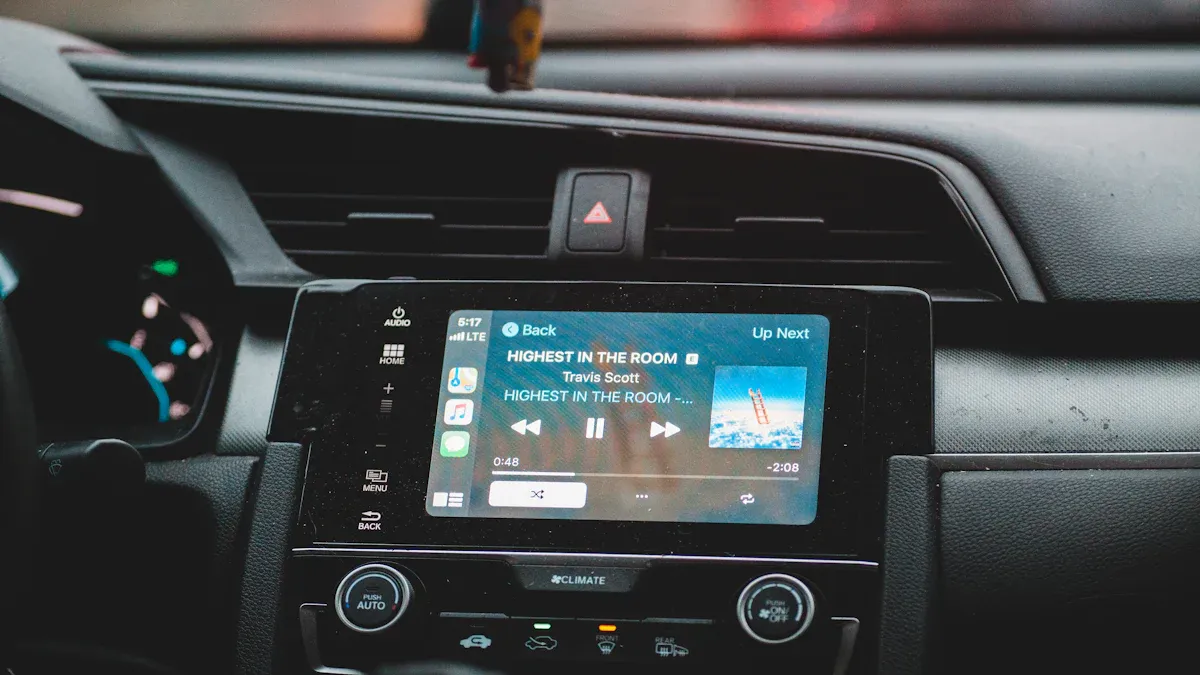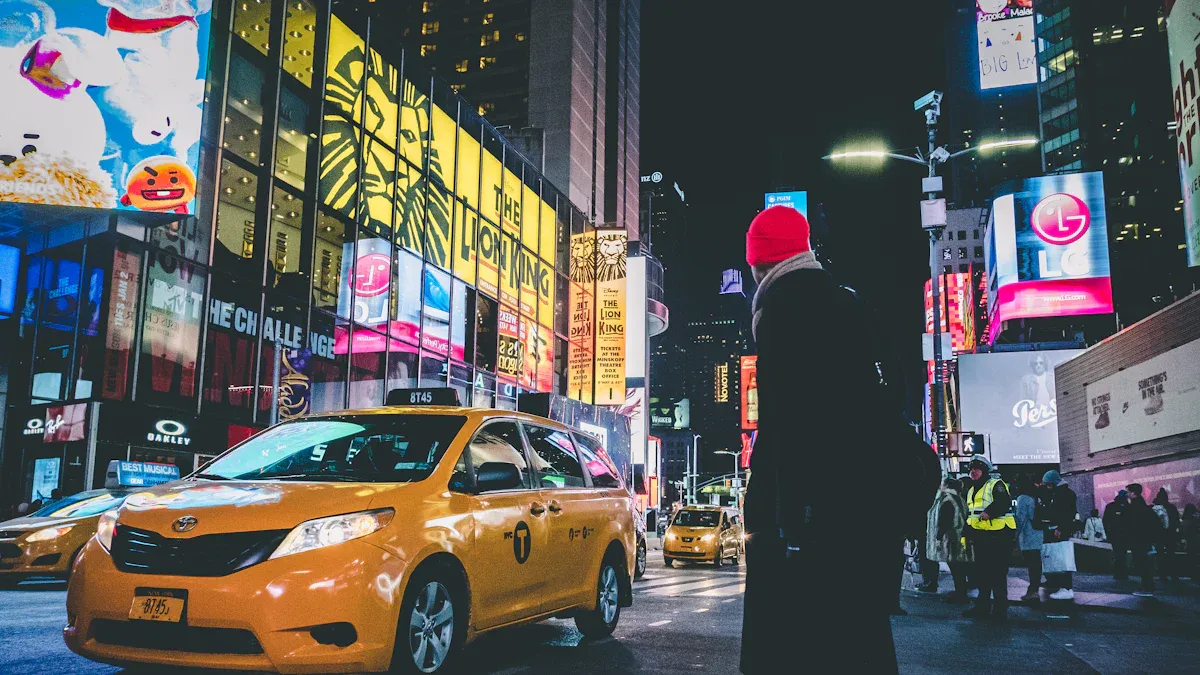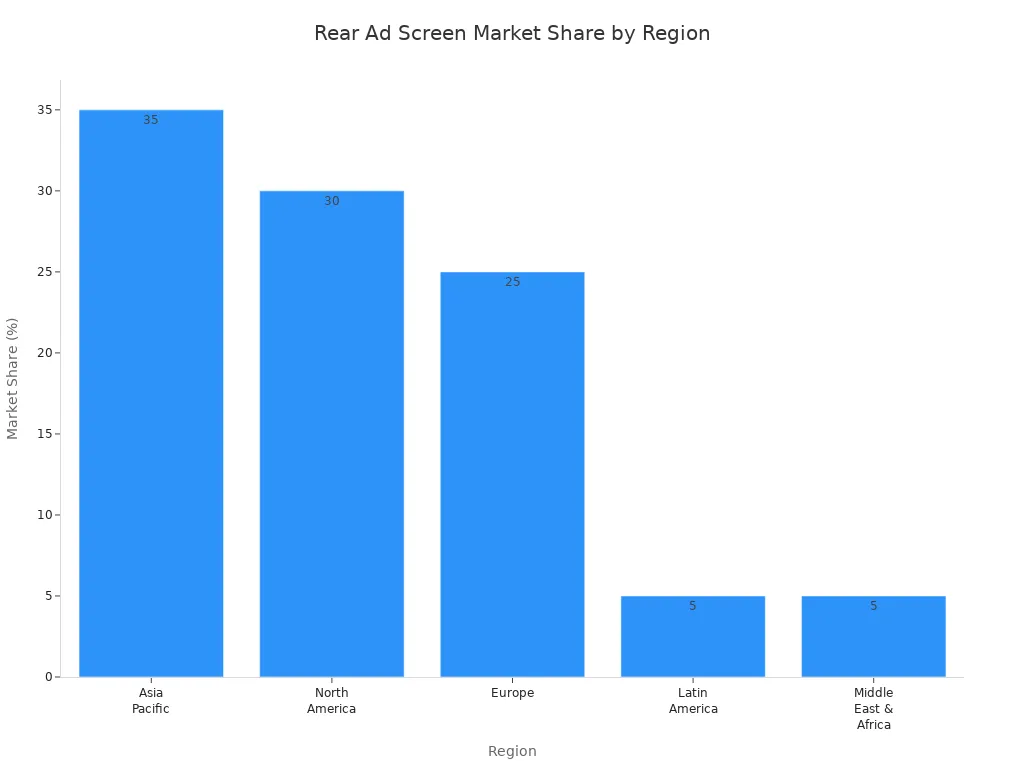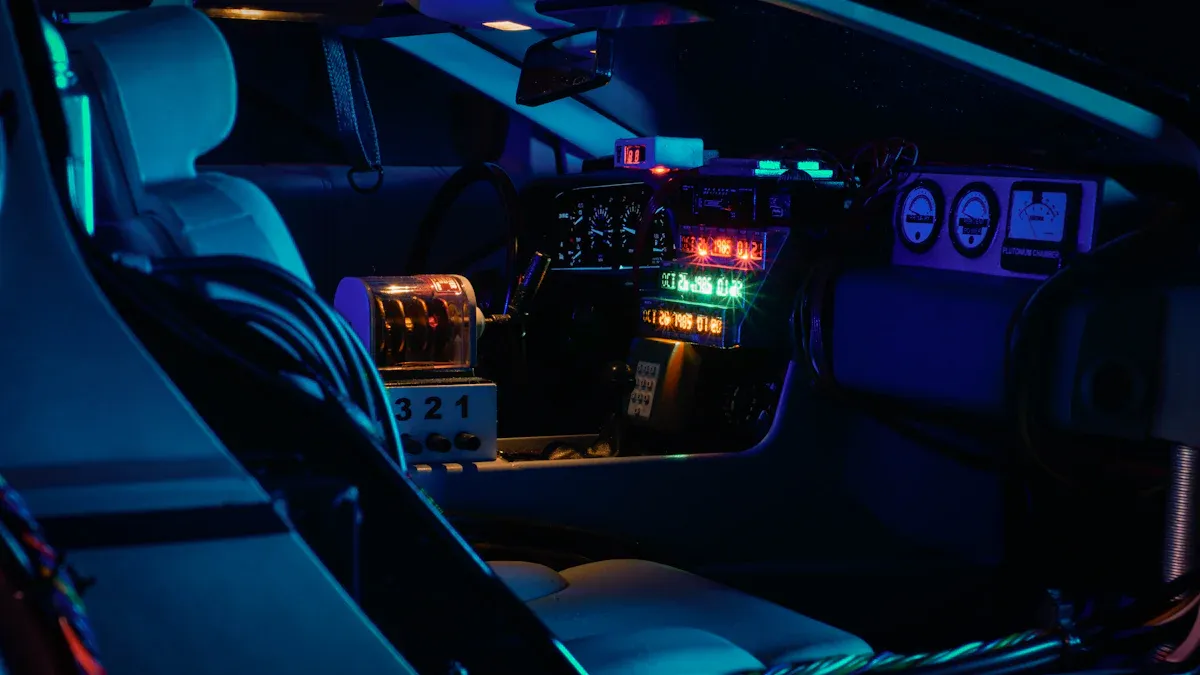
AI, IoT, and new car led advertising display technology are changing rear ad screens for ride-hailing cars. These car led advertising display systems use new sensors and smart programs to show ads for certain people. Advertisers get better results, and passengers see ads that help them more. Car led advertising display upgrades make on-car ads more fun and interactive. This new idea changes how people see brands during every ride. Rear ad screens for ride-hailing cars make each car led advertising display better for everyone.
Key Takeaways
AI and IoT help rear ad screens get smarter. They show ads that fit each passenger’s likes and where they are. OLED and LCD displays make ads look better with bright colors and sharp pictures. This makes rides more fun and interesting. Drivers can make more money by having ad screens in their cars. Advertisers can also reach the right people this way. Real-time data and GPS let ads change fast based on the car’s location. This makes ads more helpful and fun to see. Privacy, safety, and clear rules are very important. They help keep passengers safe and protect their data when using these ad screens.
Rear Ad Screens for Ride-Hailing Cars

AI-Driven Interfaces
AI-driven interfaces are now very important in car advertising screens. These systems use smart learning to make each car led advertising display better and faster. AI looks at what passengers like and changes the ads on digital advertising screens. Some systems use voice controls and learn from what people pick. They can give special entertainment and even change the climate settings. This technology makes ride-hailing trips more fun and comfortable.
AI turns cars into personal spaces with voice recognition and special entertainment.
Self-learning systems watch what users do and change each ride.
AI-driven car led advertising display platforms show ads made just for each person using real-time data.
These new tools help advertisers reach the right people with fun ads. Passengers see things they care about, so they pay more attention. This makes on-car advertising work better.
OLED and LCD Displays
The car advertising screen market is growing fast with OLED and LCD displays. Bigger OLED screens look great, bend easily, and are thin, so they fit well in new cars. These displays make digital advertising screens look cool and keep passengers interested. LCD screens are still used a lot because they look good and cost less, so many ride-hailing cars use them.
New infotainment systems with these displays give real-time updates and changing content. Passengers get to enjoy more fun and interactive trips. OLED screens, with their bright colors and bendy shapes, are used in fancy ride-hailing cars for great pictures. LCD screens last longer and are good for many in-cabin digital signs.
Note: More people use ride-sharing and spend more time looking at screens, so digital ads work better. High-definition screens, internet, and data tools let companies update ads quickly and show special content, so passengers pay more attention.
Parameter | OLED Displays | LCD Displays |
|---|---|---|
Saves more power with dark images; each pixel can turn off. | Saves more power with bright images because of the backlight. | |
Contrast Ratio | Has perfect contrast and true blacks. | 1000:1 to 5000:1; cannot show true blacks. |
Color Accuracy | Shows better colors and more shades. | Colors are better now, but not as good as OLED. |
Viewing Angles | Almost perfect, about 180 degrees. | Colors change if you look from the side. |
Lifespan & Burn-in | Does not last as long, can get burn-in. | Lasts longer, less chance of burn-in. |
These new car led advertising display technologies help the car advertising screen market give better digital ads and in-car ads.
IoT and Real-Time Engagement
IoT is a big new thing in car advertising screens. IoT devices in ride-hailing cars collect real-time data like where the car is, how it moves, and what time it is. This helps car led advertising display systems show changing ads and special messages for each passenger.
IoT gives real-time data for ads that fit the moment and place.
Special and quick marketing messages help sell more.
Location-based deals and push messages get people interested right away.
In-cabin digital signs use this data to show deals, like sales when a passenger gets to a mall. Real-time feedback and rewards make the ride more fun. These new tools help digital advertising screens in ride-hailing cars get more people to buy and make passengers happier.
Standardization Trends
Standardization trends help make car led advertising display systems work the same way in different ride-hailing cars. Companies now build digital advertising screens that fit many car models and software. This makes it easier for advertisers to run ads on many platforms and check how well they do.
Standardization also helps in-cabin digital signs and on-car ads by making sure everything works together and is reliable. As more ride-hailing companies use these standards, the car advertising screen market gets better and can grow faster. This trend helps new ideas and lets digital ads reach more people.
Market Drivers in Ride-Hailing Advertising
Advertiser Demand
Advertisers really want to use car advertising screens. Rear ad screens in ride-hailing cars reach people who cannot leave. Passengers often look at in-taxi digital signage while riding. This makes car led advertising display systems important for brands. Taxi TV has thousands of in-taxi digital signage screens in big cities. The company saw 30% more views as more brands use ride-hailing ads. Many advertisers pick in-taxi advertising because it reaches young, rich riders. These screens let brands talk to people in a new way, not like billboards.
The automotive advertising screen market keeps growing as more ride-hailing cars use in-taxi digital signage. More people live in cities and use ride-sharing, which helps this market grow. Brands want to reach passengers when they can listen to the message. The digital signage market for ride-hailing ads is special because it mixes a captive audience with smart targeting. This helps advertisers send the right message at the best time.
Revenue for Drivers
Car led advertising display systems help drivers make more money. Many ride-hailing drivers put in-taxi digital signage in their cars to earn extra. The automotive advertising screen market gives drivers some of the ad money. This extra pay helps drivers with costs and lets them earn more. In-taxi advertising also helps the digital signage market by getting more drivers to join ride-hailing.
Platforms with car led advertising display technology bring in more drivers. The chance to earn more money makes ride-hailing jobs better. In-taxi digital signage and in-taxi advertising help drivers use their time well. As the automotive advertising screen market grows, more drivers get these new ways to earn.
Data-Driven Targeting
Data-driven targeting is very important in ride-hailing ads. Car led advertising display systems use real-time data to show the best ads. In-taxi digital signage uses GPS to show ads for certain places. This geo-targeting makes passengers pay more attention and enjoy the ride. Interactive displays, like touchscreens and QR codes, let passengers use the ads and get special offers.
Real-time geo-targeting uses GPS for ads in the right place.
Touchscreens and QR codes let passengers use the ads.
Past campaign data helps make targeting better.
Good locations and special messages reach the right people.
Personalization makes in-taxi digital signage work better. Car led advertising display platforms can give special deals based on how people ride. Predictive analytics help send drivers where they are needed and cut wait times. Loyalty programs and special campaigns keep people coming back. The automotive advertising screen market uses these tools to help brands and save money.
Interactive backseat touchscreens in ride-hailing cars make passengers more interested. These screens can give out coupon codes and deals. They use passenger data, like search history and phone links, to make ads better. Using touchscreen data with smartphone data will make ads even more personal and useful soon.
Cross-Vehicle Campaigns
Cross-vehicle campaigns help brands reach more people with car advertising screens. These campaigns use data to learn about different users and places. Multichannel marketing mixes car led advertising display systems with apps, social media, email, and print. This way, brands reach people where they spend time.
Audience segmentation sends messages to the right groups.
Multichannel marketing uses apps, social media, and print.
Email and push notifications get more people to join in.
Social media ads reach the most important groups.
Partnerships help brands reach even more people.
Measuring and improving is important in cross-vehicle campaigns. Tools like LiveRamp’s Cross-Media Intelligence put data together from many places. This helps marketers see how well campaigns work and follow the customer journey. Platforms like Google Analytics and Singular help track ads on many devices for ride-hailing ads. These tools help marketers make campaigns better and get more for their money.
The automotive advertising screen market gets better with these smart, connected ideas. Brands get more leads, sales, and keep more customers. The digital signage market for ride-hailing cars keeps growing as more companies use cross-vehicle campaigns to reach their goals.
Challenges in On-Car Advertising
Privacy & Data Security
Privacy and data security are big worries for car led advertising display systems. These screens collect passenger data to show ads just for them. Companies must keep this information safe from hackers and bad use. Strong encryption and updates help protect the data. Passengers want to know how their data is used. Clear privacy rules help people trust the system. Ride-hailing advertising platforms must follow strict laws to stop data leaks.
Regulatory Issues
Regulatory issues change how companies use car led advertising display technology. Every city and country has its own rules for digital ads in cars. Some places limit how bright or what kind of ads can show. Others need special permits for ads inside cars. Companies must keep up with these rules to avoid getting fined. They also need to work with local governments to make sure car led advertising display systems are safe.
Maintenance Costs
Maintenance costs can slow down car led advertising display networks. Screens need to be cleaned and fixed often. Hardware or software problems can stop ads from working. Drivers may have to change parts or update the system. Good displays like OLED and LCD last longer but still need care. Companies must teach drivers to fix small problems. Support teams help fix bigger issues fast, so ride-hailing ads keep running.
Passenger Experience
Car led advertising display systems can make rides better in many ways:
Real-time news and weather keep riders updated.
Screens dim by themselves to keep drivers safe.
Passengers feel safer with easy emergency contacts and maps.
Drivers can pick content that matches what passengers like.
Note: Passengers give better ratings and tips when they enjoy the ride. Car led advertising display features like fun shows and safety tips make rides nicer. This means more happy customers and better reviews for drivers.
Ride-hailing advertising companies must balance making money with keeping passengers happy. Too many ads or loud screens can bother riders. The best car led advertising display systems give helpful content without being annoying. In-car ads work best when they make the ride better.
Regional & Segment Insights
Fastest-Growing Markets
The automotive advertising screen market grows at different speeds in each region. Asia Pacific is growing the fastest in car led advertising display use. Cities are getting bigger, and people have more money in China and India. This helps the market grow quickly. The region expects to grow by more than 10% each year. North America and Europe have big shares in the digital signage market. Their growth is slower but steady. Latin America and the Middle East & Africa have smaller shares.
Region | Market Share (2023) | Growth Notes |
|---|---|---|
Asia Pacific | 35% | Fastest-growing region; demand for advanced automotive tech and government safety initiatives in China and India. |
North America | 30% | Large market share but steadier growth. |
Europe | 25% | Established market with steady growth. |
Latin America | 5% | Smaller market share. |
Middle East & Africa | 5% | Smaller market share. |

More people use ride-hailing and shared rides now. This means more need for in-taxi digital signage and in-cabin digital signage. Rear-seat infotainment that is personal makes car led advertising display systems even more important.
User Demographics
The automotive advertising screen market is for young, city people who like technology. Most ride-hailing users are between 18 and 35 years old. They spend a lot of time looking at in-taxi digital signage. They also like interactive car led advertising display content. Families and business travelers also use in-cabin digital signage. They like real-time information and entertainment from the digital signage market.
Platform Differences
Ride-hailing platforms use car led advertising display technology in different ways. Some use in-taxi digital signage with touchscreens and QR codes. Others use in-cabin digital signage for news, weather, and fun. The automotive advertising screen market changes to fit each platform. This helps the digital signage market grow and reach more people.
Localized Content
Brands use automation and creative templates to make local ads for car led advertising display systems. In-taxi digital signage changes ads for each place, language, and culture. Dynamic video templates help make many versions fast. Automation lets companies update in-taxi digital signage in many places at once. Local ads that match the area help build trust and get more people interested. The digital signage market gets better results and higher returns for brands by using these ideas.
Car LED Advertising Display & Connectivity

GPS Targeting
GPS targeting has made car led advertising display better in ride-hailing cars. Now, advertisers can show ads based on where the car is. A car led advertising display might show a sports ad near jogging paths. It can also show ads for local stores when the car drives by. The automotive advertising screen market uses GPS to make ads feel more personal. Passengers spend lots of time looking at in-taxi digital signage. When GPS is used, ads match the area the car is in. This makes ads more fun and helpful for people.
The automotive advertising screen market likes GPS because ads can change fast. For example, a car led advertising display can show new ads in shopping areas or business places. It can also show different ads if the weather changes or it gets late. This helps the automotive advertising screen market reach people at the best time. Passengers see ads that fit what they need. Advertisers get better results from in-taxi digital signage.
4G/WiFi Management
Managing 4G and WiFi is key for every car led advertising display in ride-hailing cars. The automotive advertising screen market needs fast connections to update ads right away. LTE-Advanced (4G) gives wide coverage and high speed. But sometimes it is not fast enough for instant updates. Moving to 5G will help the automotive advertising screen market. 5G is faster and has less delay. This means a car led advertising display can show new ads quickly, even when the car is moving.
Good connections keep the car led advertising display working all the time. The automotive advertising screen market uses smart antennas and network tools. These help the car led advertising display stay online, even when the car moves. The system uses network slicing and edge computing to get the newest ads. The automotive advertising screen market also upgrades from old wires to new Ethernet for better speed and safety.
5G needs special antennas in cars for strong signals.
The automotive advertising screen market has trouble with network changes and keeping low delay.
New wireless and wired systems help the car led advertising display stay current.
Many 5G base stations in cities help the automotive advertising screen market and in-taxi digital signage.
The car led advertising display needs these networks to keep passengers interested and advertisers happy. The automotive advertising screen market will keep growing as these tools get better.
The car led advertising display market will grow a lot and reach $4 billion by 2028. Companies add new things like AI, data-driven ads, and fun content to car led advertising display systems. The screens use better LED technology, so ads look brighter and are safer for people and the planet. Advertisers use car led advertising display tools to show ads for certain places, run programmatic ads, and make interactive campaigns. Car led advertising display networks let brands see how well ads do and help them get better results. These systems also help the planet by using solar power and screens that clean the air. Car led advertising display technology will keep growing as cars get smarter and use more data. New trends in China and other fast-growing places will change car led advertising display platforms. These solutions help ride-hailing companies, drivers, and advertisers reach more people. New ideas in car led advertising display will change how on-car ads work.
Car led advertising display improvements will keep making rides more fun and help everyone earn more money.
FAQ
What is a car led advertising display?
A car led advertising display is a digital screen in ride-hailing cars. It can be inside or outside the car. The screen shows ads, news, or fun videos. Companies use these screens to reach people riding or walking by. LED technology makes the pictures bright and easy to see.
How does a car led advertising display work in ride-hailing cars?
A car led advertising display uses 4G or WiFi to get online. The system updates ads right away. GPS helps the screen show ads for local places. Passengers see different ads based on where they are or the time. This makes every ride feel special.
Why do advertisers choose car led advertising display systems?
Advertisers like car led advertising display systems because people watch them during rides. Passengers look at the screens while they travel. The screens use data to show ads that fit each person. This helps brands talk to the right people and get more attention.
Are car led advertising display screens safe for passengers?
Car led advertising display screens follow safety rules in cars. The screens get dimmer at night so drivers are not distracted. Companies make sure the screens fit safely in the car. Passengers can use the screen for emergency contacts or maps if they need help.
Can drivers earn more with a car led advertising display?
Drivers can make extra money with a car led advertising display. The system gives drivers some of the ad money. This helps pay for car costs. Many drivers join ride-hailing because they can earn more this way.
Tip: Drivers who use a car led advertising display often get higher ratings from passengers who like the extra entertainment.
See Also
Budget-Friendly Portable CarPlay Solutions Suitable For All Drivers
Leading Developments Influencing Android Auto Wireless Adapter Tech
Why AI Box CarPlay Will Be Essential In 2025
Audi Tesla-Inspired CarPlay Displays Reviewed By Features And Cost
